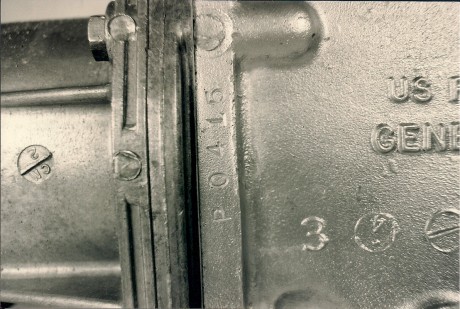Although all previously published data has denied or excluded the existence of the 1965 M22 transmission, this author has uncovered the trail behind this mystical transmission. The complete history of M22 prototypes is covered in Volume 2 of the book series “Chevrolet by the Numbers” but what is covered here is the proof of the 1965 M22 and how it came to be installed in 1965 Corvettes and passenger cars.
I had heard rumors for many years that Chevrolet had produced a special run of 1965 M22 transmissions, but I could never find any proof to substantiate the claim. Many Corvette (NCRS) officials still refuse to discuss the possibility that this transmission was installed in 1965 Corvettes. I believe that with the documentation presented here, there should be no doubt left in anyone’s mind that this series of events took place.
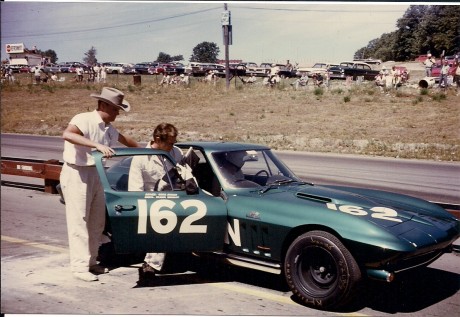 Second owner Gord Dewar just won 1966 Mosport Grand Prix, now going out for victory lap.
Second owner Gord Dewar just won 1966 Mosport Grand Prix, now going out for victory lap.
During the Grand Sport Corvette Race Program, Chevrolet instituted a field test using the M22 transmission. This field test was successful and specific design changes were made to the existing Muncie transmission platform to bring M22 production units into existence. A Chevrolet Engineering Change Recommendation #68715 was issued on December 19, 1964, that proposed the changes required to change the M20-21 into the M22 rockcrusher transmission. This ECR is referred to several times through the 1965 Corvette A.I.M. (Assembly Instruction Manual) with the date stated on the A.I.M. sheets as April 23, 1965. This same ECR states that the M22 is to be used with Corvette options RPO L76, L84, and L78 for 1965. This transmission was also released for the 1965 passenger car with the L78 engine. One thing that must be kept in mind here is that this document does not prove that any M22 transmissions made it to production vehicles.
During my research on Muncie transmissions, I gained clearance to visit the Muncie assembly plant in Muncie, Indiana. Many of the original key employees have now retired. I looked for original documents at the plant for several days. After failing to turn up anything in their basic files room, I was taken to a dingy upstairs room above the plant, which was padlocked and surrounded by a woven wire fence (Similar to the Chevrolet Central Office Records Retention Area in Introduction.) In this room, I proceeded to find the build records, shipping records, transmission code sheets, and transmission build sheets for all Muncie transmissions for almost twenty years. Little did I realize that at that time I had found the proof needed to validate the 1965 M22 transmission.
 This photo shows the 1965 M22 with the side cover off as it was removed from the unrestored Corvette.
This photo shows the 1965 M22 with the side cover off as it was removed from the unrestored Corvette.
The first substantial piece of documentation I found concerning the 1965 M22 transmission was the complete breakdown sheet for all M22 transmissions from 1965 through 1974. This sheet lists by model year, each M22 assembly shipped from Muncie with accumulative totals across the bottom of the page. Across the top of the page are the words “First Build 4/15/65 – 1st Shipment 4/19/65, recap of M22 (Rock Crusher) Trans.” By comparing these M22 transmission assemblies to Chevrolet’s 1965 transmission identification codes, I found a perfect match. This transmission identification code list was issued by the Chevrolet Facilities and Product Planning Department Planning Section. This code list listed the model code, RPO (regular production option), specific transmission type, gear ratio, transmission part number, and transmission letter code designation. At the bottom of the transmission codes page, there are notations dated March 25, 1965 that these same transmissions were added to the codes list. This document is stamped “Received March 31, 1965 Chevrolet Material Department. Muncie.” Since the complete breakdown sheet only gives the total M22 units built, I then had to refer to the accumulative shipments lists which would give me a breakdown of the total units. On this shipment list, there are several columns which show assembly plants, GM of Canada, McKinnon Industries, Oldsmobile, Pontiac, Service and SS Automobiles. By referring to this sheet I could tell which transmissions were built and where they were sent. From the comparison of these three documents, I have deducted the following breakdown of 1965 M22 transmissions which were installed in production in assembly line vehicles.
At this time during my research, I realized that even though all of this documentation was great, I needed a legitimate car to verify that these transmissions had actually made it to a factory assembly line. I contacted an old friend of mine, Darrell Sheppard, (of 4-Speeds by Darrell fame) who had helped quite a bit with the book project already. Just by chance, he had just been contacted by someone who said he had a 1965 M22 transmission and was looking for specific information pertaining to the possibility that Muncie built these transmissions. Darrell gave me the name of this gentleman and I gave him a call. He proceeded to tell me that the car he had just bought a car which had an extensive race history and he had complete documentation as to how the car was ordered, shipped and delivered. Since this car was a Canadian shipped car, he also had the shipping records from Chevrolet of Canada. He immediately sent some snapshots to me of the transmission which started several months of letters and phone calls. He also later supplied me with more detailed photographs of the transmission.
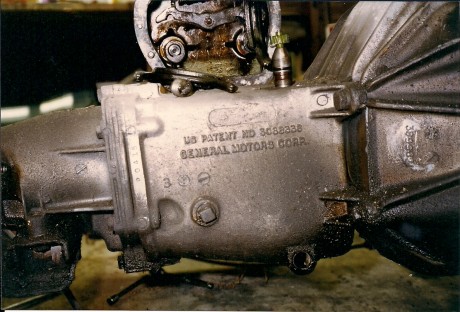 Passenger side of the unrestored M22 transmission.
Passenger side of the unrestored M22 transmission.
There are several interesting features which are special in the 1965 M22. All 1963-65 M20 and M21 transmission used a 7/8″ countergear pin in all assemblies. During prototype testing, this 7/8″ countergear pin was found to be the weak link in upgrading the Muncie transmission. This upgrade was mandatory due to the advent of newer and more powerful engines that were to be introduced to the Chevrolet engine lineup for the next several model years. Although other sources have stated that the upgrade to a new 1″ countershaft pin bore started with the 1966 model year, it actually began in the 1965 M22 transmission.
Another change for the M22 was the new low helical-angle cut gear set which increased the inner strength of the transmission dramatically. This gearset was quite noisy and from all indications was called the “Rockcrusher” transmission from the beginning by all Chevrolet and Muncie engineering staff. The 1965 M22 maintained the 10-spline input and 27-spline output as all other Muncie transmissions from that model year.The 1965 M22 also had the drain plug boss drilled and tapped for a magnetic drain plug. This was not done on the M20 or M21 transmissions.
 Driver’s side of restored 1965 M22 transmission.
Driver’s side of restored 1965 M22 transmission.
There are several features on this specific M22 transmission which should be mentioned here. The primary feature which seems odd is that the casting number on the main transmission case has been routered off. This was done intentionally to these transmissions to take off the original casting number. The 1964-65 Muncie transmission main case casting number was #3851325. It was designed for the use of the 7/8″ countergear pin inside the transmission assembly. To manufacture the M22, the #3851325 case had to be drilled out to 1″ to accept the special countershaft pin. A new maincase was not to be released until the start of the 1966 model year. Since the Muncie transmission plant did most of their own prototype work, they had a special assembly line set up in which all prototype transmissions were run. If there were any changes made to the maincase, all original casting numbers were routered off the maincase so all internal personnel would realize that the case had been altered in some way. Since there were only 57 M22 transmissions built in 1965, the cases were routered off just like a typical protype. The primary reason the M22 transmissions went down this line was because internally they were regarded as limited-production assemblies with a modified or altered maincase. The M22 continued to use the same tailhousing, side cover and front bearing retainer as all other Muncie transmissions.
The final aspect of this transmission which solidifies this information is the fact that this transmission had to be built on or after April 15, 1965, due to the original M22 breakdown sheet which has the words “First build 4-15-65 – 1st Shipment 4-19-65 at the top. When I originally contacted the owner of this car, I did not mention the date at the top of this page. It was quite a revelation when I received the photographs that you see pictured here, and the date matched exactly to the breakdown sheet. Also, the correct VIN was stamped into the maincase which matched all the paperwork to be mentioned later.
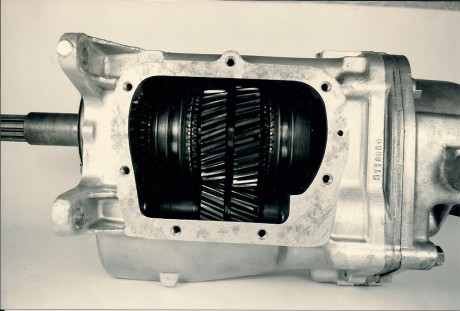 Passenger side of restored 1965 M22 with side-cover removed.
Passenger side of restored 1965 M22 with side-cover removed.
Since this particular Corvette has played such an important part in this research, I believe that the documented history of this car deserves mentioning here. This 1965 Corvette was ordered by David G. Billes of Willow Dale, Ontario, Canada on March 22, 1965, from Gorries Chevrolet/Oldsmobile in Toronto. Mr. Billes owned Canadian Tire, a huge auto parts and hardware chain throughout Canada. The car was ordered specifically for racing purposes and, as you can see from the original order form, was equipped with the 396/425 HP engine, transistor ignition, F40 suspension and the very rare N03 36 gallon fuel tank. In the special instructions box under accessories, please note that this was a rush-competition car from day one. Also note that the car was ordered black with black trim in the top right box. The car was raced competitively during the 1965 racing season including the Canadian Grand Prix, at Mosport Park in Canada.
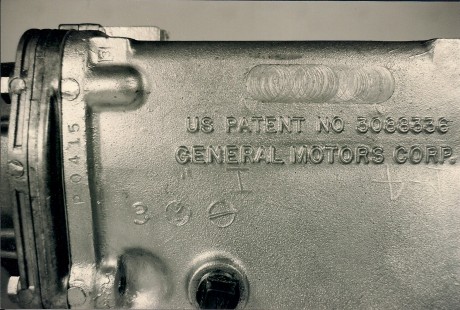 Passenger side of 1965 M22 restored transmission. Note where casting # has been milled off the main case. To the left, note P0415 build date.
Passenger side of 1965 M22 restored transmission. Note where casting # has been milled off the main case. To the left, note P0415 build date.
The next piece of documentation was the factory car order which was sent to Gorries Chevrolet to state how the car was to be built and that it was now awaiting production. On this document the 4 speed transmission option code listed the transmission as an M20. In 1965, all 4 speeds were ordered initially by the M20 4 speed designation. Depending upon the rear axle ratio, Chevrolet supplied either the M20 wide ratio or M21 close ratio transmission at their discretion. It has not been determined at this point of documentation which transmission will be supplied to the car at final assembly. Also the carwas assigned the factory car order number of #913211. This number is used to designate this particular car, the options assigned to it, and the schedule to build the car.
 Close up where original casting # has been milled off case.
Close up where original casting # has been milled off case.
Also included from the owner was the photocopy of the Chevrolet Canadian build shipping record sheet. This sheet discloses date shipped, shipping control number, model type, vehicle identification, arrival date, trim, paint, and dealer number in columns, moving left to right. This particular Corvette’s entry is the second from the last on the page. It shows shipping date of 6/17 and a factory control number of #913211 which matches the factory car order. The model is listed as 19437 (Corvette Coupe) as well as the VIN #S118966. This is the first time the VIN number is listed. This VIN number is stamped into the transmission case. The next column is the 6/17 arrival date, the next column was left blank because the car was receiving the standard black interior. The next column is the “AA” black paint code with the final column designating the 5526 dealer number which was Gorries Chevrolet. The actual body build date of the car is June 2, 1965. Please note that this car was to be delivered June 17. The order date was March 22, 1965. This car took 86 days to build on a rush order. It is believed that this car was late due to the fact that it was a N03 car and many of these cars were built and overseen by Zora Argus Duntov at the General Motors Tech Center.
The final piece of documentation regarding this car is the original salesman’s copy of the delivery transaction. This sheet clearly shows the VIN #5S118966, the factory car order #913211, and all of the options which were installed in the car. The transmission designation is now M22, designating that this car was final assembled with the aforementioned transmission. There is one mistake on this sheet in that the color of the car is listed as blue. The car was delivered black and the original trim tag reflects this as well.
FINAL COMMENTS
As I said before, I believe that the information presented here clearly substantiates the existence and building of the 1965 M22. I have given many specific details to these transmissions which could possibly be used to “create” a new flurry of 1965 M22 equipped cars. I want to warn anyone who might consider this fraudulent act: I have purposefully omitted some details relating to the 1965 M22 for this very reason. I also have the original Muncie shipping records which designate which transmissions were shipped and when they were shipped. It would be foolish at this point to try to counterfeit a similar transmission without the final pieces to the puzzle. If you happen to have a legitimate M22 car or transmission, please contact me at info@alancolvin.com.
